Croatia / Republika Hrvatska – Let’s explore here
What’s it like in Croatia?
Croatia has a stunningly beautiful and very long coastline that lies entirely on the Adriatic Sea in Europe. It’s peppered with loads of amazing islands that can be accessed via turn-up-and-wait ferries. The sea is crystal clear, there’s year round sunshine, the people are super friendly and the food is delicious. You can even apply to stay and work for an extended time as a digital nomad. What more could you ask for?!
Inland the terrain is mostly flat or hilly, particularly in the north where it reaches towards Hungary (also super flat!). The capital, Zagreb lies in the middle of a large basin, bordered in the north by small mountains. The incredible Plitvička lakes National Park with its amazing colours and waterfalls is definitely worth a visit. Croatia’s highest point is Mount Troglav in the Dinaric Alps, at 6,276 ft (1,913 m) above sea level.
It’s about a quarter of the size of the UK, and its population is around four million people (2023). It has land borders with Bosnia and Herzegovina, Hungary, Montenegro, Serbia and Slovenia.
Its rich history spans Roman ruins, medieval towns, and Venetian influences, with cities like Dubrovnik, Split, and Pula offering a blend of ancient architecture and modern charm. Croatia is famous for its delicious cuisine, influenced by Mediterranean and central European flavours, as well as its vibrant cultural heritage. The country is a popular travel destination, renowned for its natural beauty, historic landmarks, and warm, welcoming atmosphere.

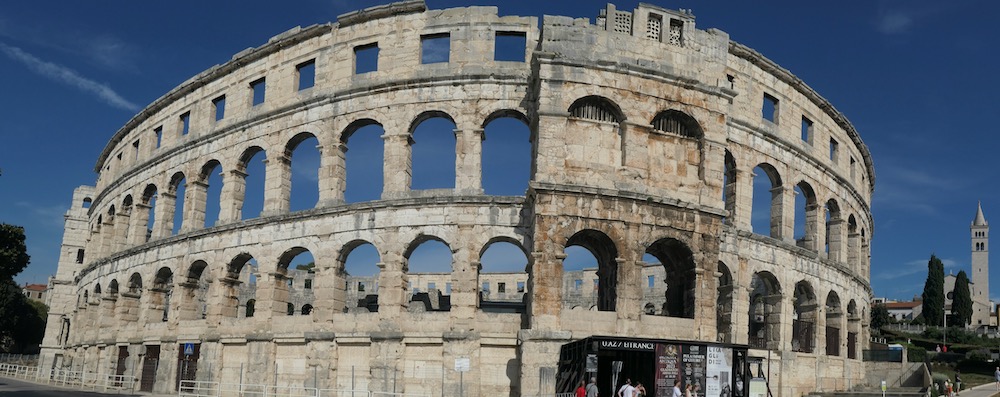
A bit about the history of Croatia
Croatia has a rich history shaped by its geographic position in south east Europe and its interactions with various empires and cultures.
Early History and Medieval Period
The area now known as Croatia was inhabited by Illyrians before becoming part of the Roman Empire. After the fall of Rome, the region was ruled by various Germanic and Slavic tribes. By the 9th century, Croats settled in the region, establishing a principality. In the 10th century, Croatia became a kingdom under King Tomislav and was recognized as a medieval European kingdom.
Union with Hungary and Ottoman Threat
In the 12th century, Croatia entered into a personal union with Hungary, and the region experienced both independence and integration with Hungarian and later Austrian rule. During the 15th and 16th centuries, Croatia faced constant threat from the Ottoman Empire, which captured large portions of the territory.
Habsburg Rule
In the 17th century, Croatia became part of the Habsburg Monarchy (later the Austro–Hungarian Empire), and the region experienced relative stability. However, tensions between Croats and other ethnic groups in the empire grew, especially as Croatian national identity began to emerge.
Yugoslavia and WWII
After World War I, Croatia became part of the newly formed Kingdom of Yugoslavia, which included several South Slavic nations. During World War II, Croatia was part of the Axis-aligned Independent State of Croatia, a Nazi puppet state that committed atrocities, including the genocide of Serbs, Jews, and Roma. After the war, Croatia became a republic within communist Yugoslavia under Josip Broz Tito.
Independence and the Croatian War of Independence
In the early 1990s, following the collapse of Yugoslavia, Croatia declared independence in 1991, leading to the Croatian War of Independence. The war, which involved heavy fighting between Croatian forces and Serbian forces (supported by the Yugoslav People’s Army), ended in 1995 with Croatia’s victory and international recognition.
Modern Croatia
Croatia became an independent state and a member of the United Nations in 1992. The country joined the European Union in 2013 and NATO in 2009. Today, Croatia is a democratic republic with a growing economy, although it continues to address issues related to its wartime past and regional stability. Its rich cultural heritage and stunning Adriatic coastline make it a popular tourist destination.

Croatia road trip
We’ve created a blog for our road trip to Croatia. We’ve been to Croatia several times, and so on this road trip, we wanted to explore inland rather than the coast. Our Creatian road trip was part of a much larger European road trip.
The eastern flat lands
On our Croatia road trip we ended up travelling through the country three times. Initially we travelled from Hungary, through the hills of Croatia to the flat lands around Osijek and Kopačev. This quite surprised us, as in all the times we’ve been to Croatia before, none of it had been flat. In fact mostly it had been spectacular coastal cliffs! Osijek and Kopačev were great … super relaxing, and really friendly.
The capital
From there we drove west on to the interesting capital, Zagreb. Capital cities are almost always quite different from the rest of the country, and Zagreb is the same. We stayed really centrally with a private lock up for our car, and ended up walking about everywhere, meeting loads of people, and really enjoying the city. It was red hot when we were there, and everyone was keeping to the shade.
The lakes and Roman Pula
We travelled down to the amazing Plitvička lakes, which are a definite must see in Croatia before moving up along the coast to the lovely Roman town of Pula, and then on to Slovenia.
We met loads of people who were willing to share some of their stories, including a British Royal Family obsessive! and an Albanian taxi driver that would very much like to meet a nice girl 🙂 There’s more about some of these people in the blog.
The fog and the mist
On our second and third journeys through Croatia, we were really surprised to find so much of inland Croatia covered in fog and mist. It seems that this is a regular occurrence, due to the layout of the terrain. Everyone on the motorways and main roads slowed down to a crawl, before haring away as soon as it lifted.
Map of our first road trip through Croatia
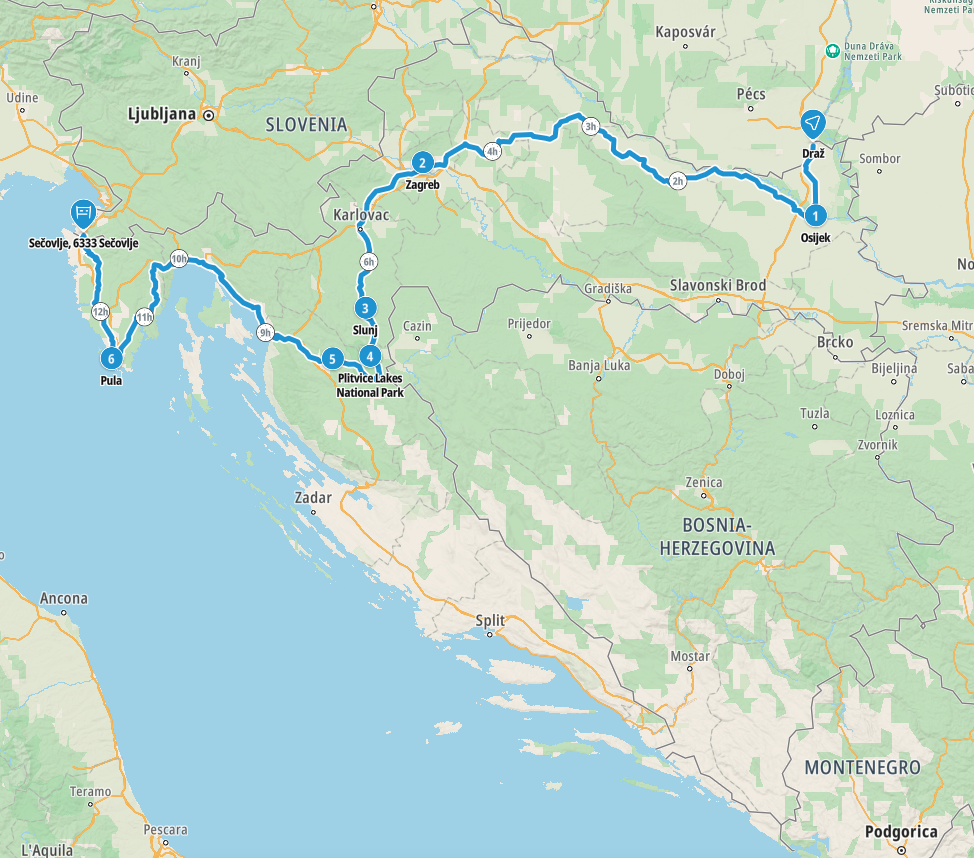
This is a map of the road trip that we took through Croatia on our travels from Hungary to Slovenia.
Our route took us from Osijek – Kopačev – Zagreb – Slunj – Plitvička lakes – Zalužnica – Pula
We’ve been to Croatia several times, so we mostly avoided the coast from Zadar downwards for that reason.
Map of our second road trip through Croatia
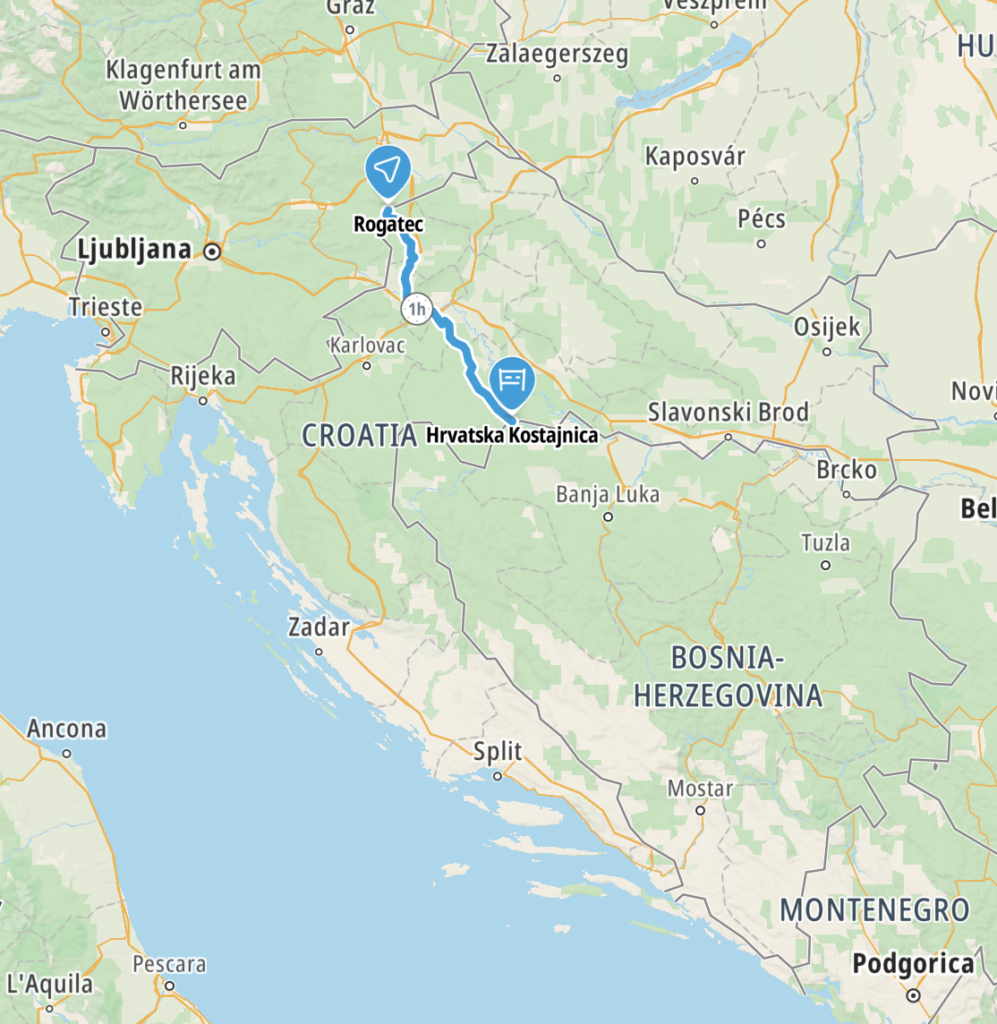
This is a map of the road trip that we took back through Croatia on our travels from Slovenia to Bosnia and Herzegovina.
This route bypasses the capital, Zagreb. In late October the entire route was blanketed in dense fog.
Map of our third road trip through Croatia
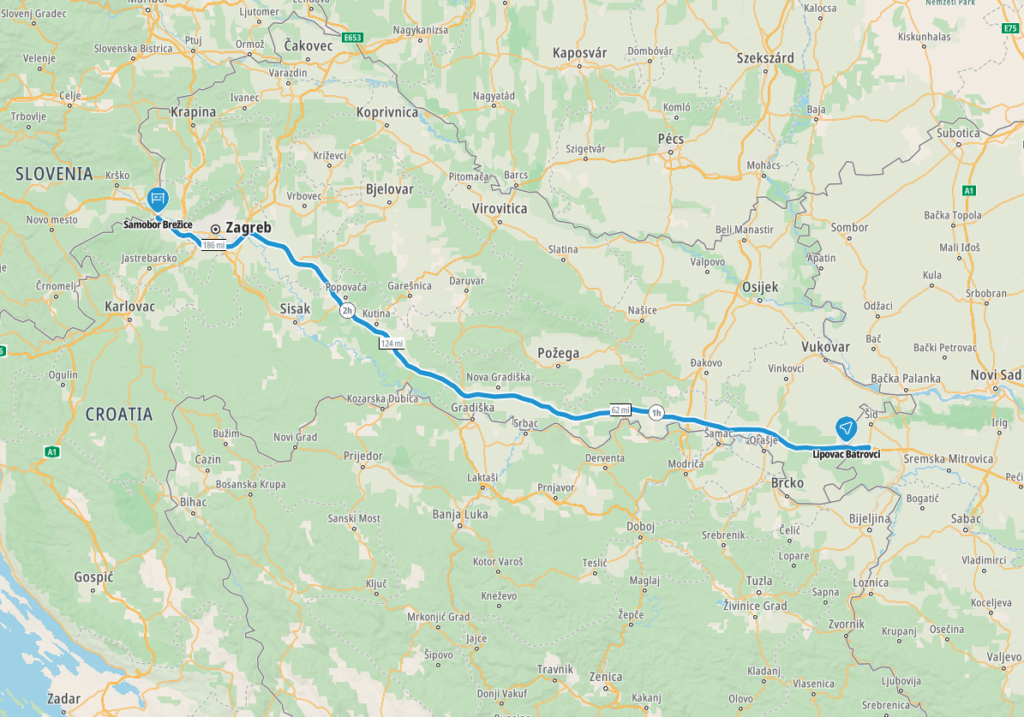
Previous Croatian roads trips
One of our best prior road trips to Croatia involved taking in Split, Dubrovnik and the magnificent island of Hvar. Once on Hvar, we explored the island thoroughly, travelling to lots of the hidden bays, as well as taking in the main towns of Hvar, Jelsa, Stari Grad and Sucuraj. In those times there was no bypass around the Bosnia and Herzegovina coast, and thus you had to drive into BIH to get to Dubrovnik.
Map of our previous road trip through Croatia

This is a map of the road trip that we took from Split to the island of Hvar and down to Dubrovnik.
Our route took us from Split – Makarska – Drvenik – Sucuraj – Jelsa – Stari Grad – Hvar – Neum – Dubrovnik – Podstrana – Split
Our favourite places in Croatia
These are some of the best places that we explored on our road trip through Croatia. We’ve put them in alphabetical order.
Bale

Bale is a picturesque town located on the western coast of Istria. Known for its medieval charm, there are narrow, cobblestone streets, traditional stone houses, and beautiful views of the surrounding countryside.
The town’s historic centre is home to the Saint Julian Church and the Castle of Soardo-Bembo. It’s is also famous for its proximity to natural attractions, like the Brijuni Islands National Park, making it a great base for exploring Istria.
Branjin Vrh
Branjin Vrh is a small village located in the Istrian region of Croatia, near the town of Pazin. Known for its tranquil rural atmosphere, the village is surrounded by lush forests, rolling hills and traditional stone houses. This is the Church of the Exaltation of Holy Cross.
Branjin Vrh is also close to the famous Lim Bay and Pazin Cave, making it an ideal base for exploring the natural wonders of Istria.

Buje

Buje is a charming town located in Istria, near the border with Italy and Slovenia. Known for its medieval atmosphere, Buje sits atop a hill, offering panoramic views of the surrounding countryside and the Adriatic coast.
The old town’s centre features narrow streets, stone houses, and landmarks such as the Church of St. Servulus and the Buje City Walls.
Grožnjan
Grožnjan is a picturesque hilltop town in Istria, known for its charming medieval architecture and vibrant cultural scene. Often referred to as the ‘Town of Artists’, Grožnjan is home to numerous art galleries, music studios, and annual festivals, particularly during the summer months.
Its narrow, cobbled streets are lined with stone houses, and the town offers breathtaking views of the surrounding countryside and the Mirna River valley.

Hrvatska Kostajnica
Hrvatska Kostajnica is a small town in central Croatia, located on the Una river, near the border with Bosnia and Herzegovina. It’s known for its rich history and has several historic landmarks, including the Kostajnica Fortress, a medieval stronghold offering panoramic views of the surrounding landscape. The town is also famous for its natural beauty, with nearby forests and the Una National Park providing opportunities for outdoor activities like hiking, fishing, and kayaking.

Hvar island and Sucuraj
One of our favourite islands is Hvar – about halfway between Split and Dubrovnik along the coast. We stayed in the bustling ferry port of Sucuraj. Most move on from here to go to the town of Hvar, Jelsa or Stari Grad. However we found that with its multitude of local restaurants, its non-crowded beaches and its willingness-to-help and smiley inhabitants – it was the perfect place to stay.
Hvar Town
Hvar is located in the Adriatic Sea, part of Croatia’s Dalmatian Islands. Known for its stunning beaches, crystal-clear waters, and vibrant nightlife, Hvar is a popular destination for both relaxation and adventure. The island is rich in history, featuring the historic Hvar Town, with its 16th century architecture, the Fortica Fortress, and the stunning St. Stephen’s Square. Hvar is also famous for its lavender fields, vineyards, and olive groves, making it a haven for nature lovers. Its combination of natural beauty, rich history, and lively atmosphere makes Hvar a must see destination in Croatia.







Sućuraj
Sućuraj is a lovely coastal town located on the eastern tip of Hvar. Known for its tranquil atmosphere, it offers beautiful beaches, crystal-clear waters, and stunning views of the surrounding islands. Sućuraj is one of the island’s oldest settlements, with historical landmarks such as the St. George’s Church and the Sućuraj Fortress. The town has a laid-back vibe, making it a perfect destination for anyone seeking peace and nature. It’s a great spot for sailing, fishing, and hiking, with picturesque landscapes and a small but welcoming community.




Dubrovnik
Dubrovnik, often referred to as the ‘Pearl of the Adriatic’, is a historic city located on the southern coast of Croatia. Known for its well-preserved medieval architecture, Dubrovnik is a UNESCO World Heritage site. The best landmarks include the Rector’s Palace, Sponza Palace and Dubrovnik Cathedral. The city is also famous for its role in the filming of Game of Thrones, attracting fans from around the world.
The city’s iconic Old Town is surrounded by massive stone walls, which you can pay to walk along to get panoramic views of both the town and the sea. Dubrovnik’s blend of cultural heritage, natural beauty, and vibrant atmosphere makes it a must-visit destination.











Kopačev
Kopačev is a small village located in the eastern part of Croatia, near the city of Osijek. It is best known for being situated within the Kopački Rit Nature Park, one of Europe’s largest wetland areas and a UNESCO Biosphere Reserve. The village serves as a gateway to the park, which is renowned for its rich biodiversity, including numerous species of birds, fish, and plant life. We stayed at the camp family kopacevo camp site, which we highly recommend. The staff are excellent and super friendly, and the showers and kitchen are great. The whole area is a haven for nature lovers and anyone seeking tranquility amidst stunning natural surroundings.




Korana
Korana is a small picturesque village located in central Croatia, near the town of Slunj. It is best known for its proximity to the Korana River, which is famous for its clear waters, waterfalls, and scenic beauty. The river flows through the nearby Plitvička Lakes National Park, a UNESCO World Heritage site, enhancing the area’s natural appeal. Its tranquil surroundings, traditional stone houses, and beautiful landscapes make it a hidden gem and a great spot to stop for a break.


Krasica
Krasica is a small village located in the central part of Istria. Known for its picturesque rural landscapes, Krasica offers a tranquil escape surrounded by lush greenery, vineyards, and olive groves. The area is part of the Istrian wine producing region, where local wineries offer tastings of the famous Malvasia and Teran wines. Krasica is also close to the historical town of Pula, known for its Roman ruins and coastal beauty.




Osijek
Osijek is a vibrant city located in eastern Croatia, along the Drava River, close to the border with Serbia. It is the fourth largest city in the country and a cultural hub of the Slavonia region. It’s known for its historical architecture, including the Osijek Fortress and the impressive St. Peter and Paul Cathedral, which dominate the city’s skyline. The Tvrđa, a well-preserved Baroque district, is a major highlight, offering charming streets and picturesque buildings. The city also boasts beautiful green spaces, such as Kopacki Rit Nature Park. It has a long and interesting history, having been ruled over by many different conquerors. Today it’s a bustling city that’s more authentically Croatian than many of the coastal tourist towns.





Plitvička lakes
Plitvička lakes are gorgeous! It’s the largest and oldest natural park in Croatia comprising of many, many waterfalls and lakes, all connected via a network of lovely natural paths through forests. Once you’ve paid to get in, all of the coach rides and ferry rides are free should you wish to travel that way. It’s an expansive set of wonders that takes most of a day to explore. Well worth a visit! There’s more in our Croatia blog on Plitvička lakes.
It’s located in central Croatia, and is the country’s most popular tourist attraction. Each year there are over 1 million visitors.

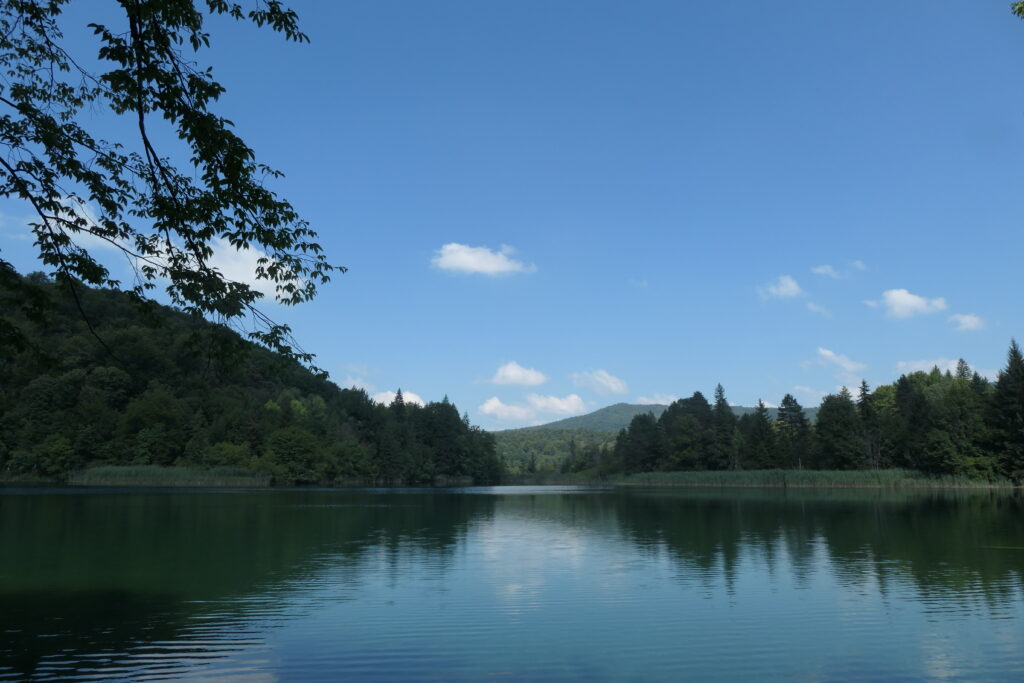

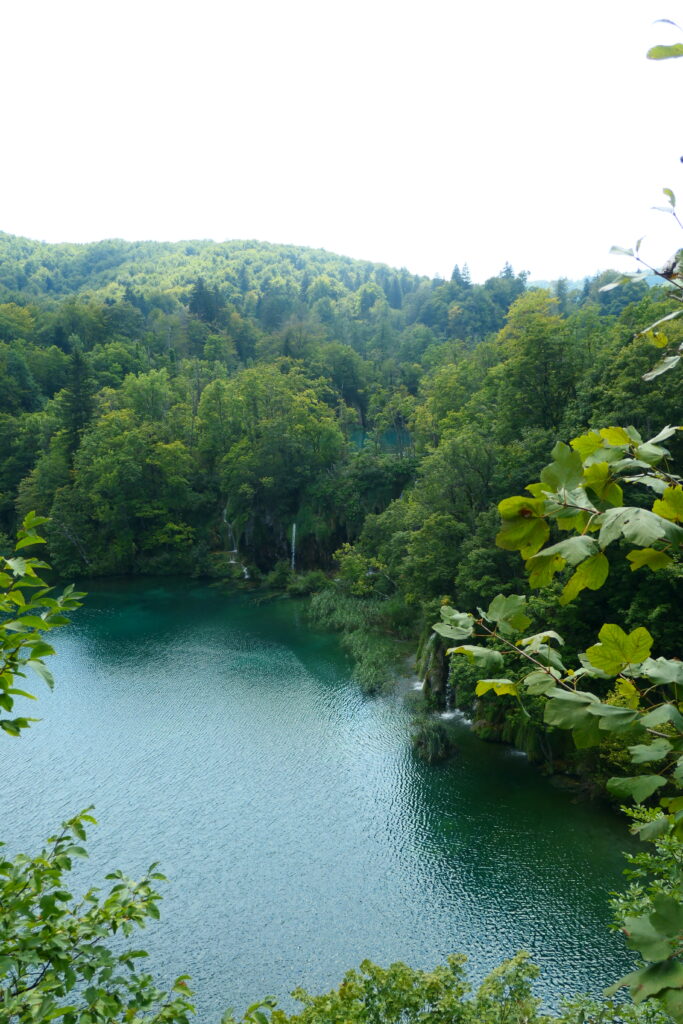



Pula
Pula is an amazing town that has some of the best preserved Roman antiquities we’ve seen! It’s located in the north west of Croatia, on the coast.




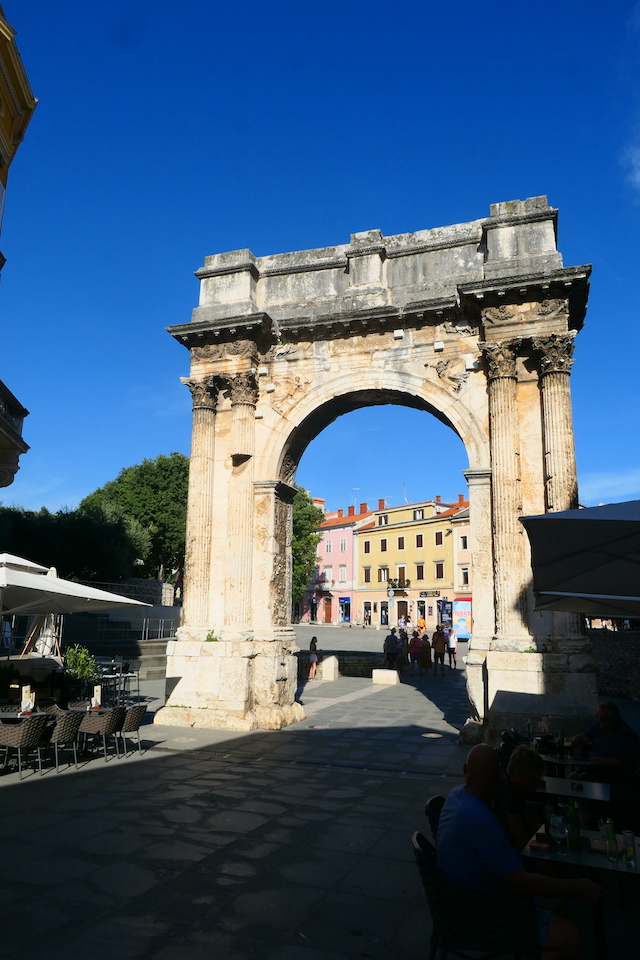





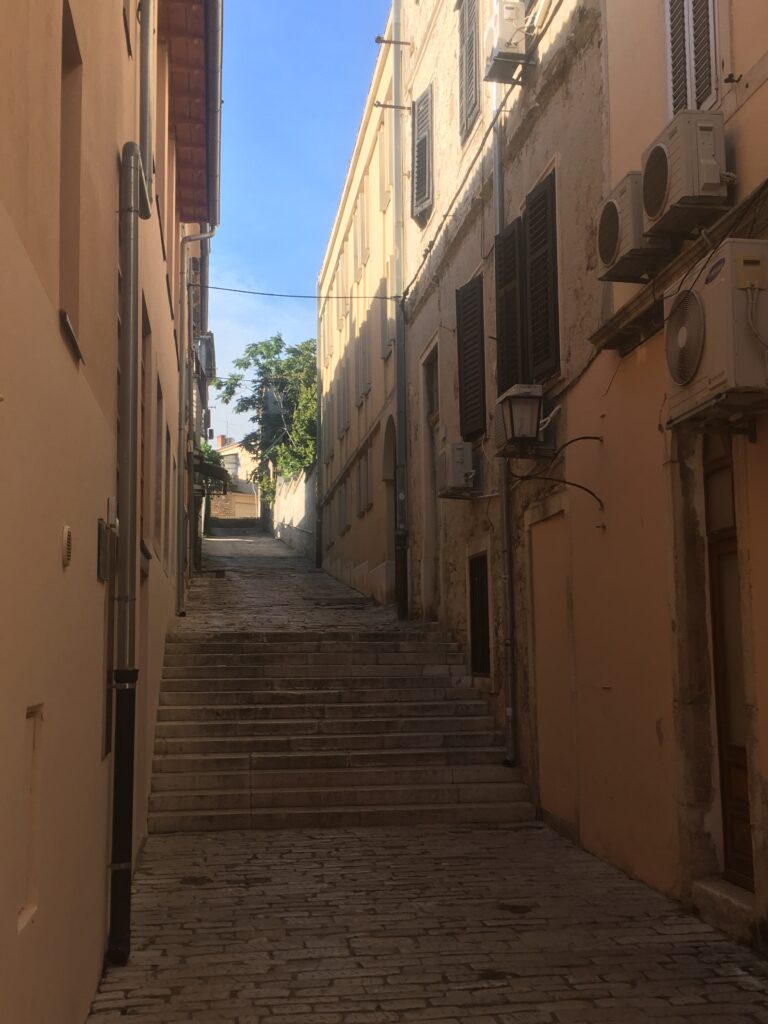



Senj
Senj is a historic coastal town located on the northern Adriatic Sea in Croatia. Known for its stunning landscapes, Senj sits between the mountains and the sea, offering spectacular views of the coastline and nearby islands. The town is rich in history, with landmarks such as the Nehaj Fortress, which offers panoramic views and tells the story of the town’s past as a stronghold against Ottoman invaders. Senj is also famous for its annual Senj Carnival, a lively celebration of tradition.


Senjska Draga
The Serpentine Senjska Draga Road is a scenic, winding mountain road that connects Senj to the village of Senjska Draga in northern Croatia. This serpentine route is known for its breathtaking views, as it snakes through the rugged Velebit Mountains and offers panoramic vistas of the Adriatic Sea and the surrounding landscape. The road’s sharp bends and steep inclines make it a thrilling drive, with each turn unveiling new, picturesque scenes of the Croatian coast.




Slunj
Slunj is a lovely town located in central Croatia, known for its picturesque setting at the confluence of the Slunjčica and Korana rivers. The town is famous for its unique Watermills of Rastoke, a historic settlement where the rivers flow over waterfalls, creating a stunning natural spectacle. Slunj is also close to Plitvička Lakes National Park, making it a popular base for visitors exploring the park’s waterfalls and lush landscapes. It was also the home of Milan Neralić, who was the first Croatian Olympian and who won a bronze medal for fencing.


Šušnjevica
Šušnjevica is a small village located in the heart of the Istrian Peninsula. Known for its traditional charm, Šušnjevica offers a peaceful rural atmosphere surrounded by scenic hills, vineyards, and olive groves. The village is part of the municipality of Tinjan and retains much of its rustic character, with stone houses and narrow streets. Šušnjevica is situated near the Lim Bay, a protected natural area known for its stunning coastline and biodiversity.

Učka Nature Park
Učka Nature Park is located in the Istrian Peninsula, encompassing the Učka Mountain and surrounding landscapes. The park is known for its rich biodiversity, featuring diverse flora and fauna, including rare species of plants and animals. The Učka Mountain, with its peak Vojak, offers stunning panoramic views of the Adriatic Sea and the Kvarner Gulf, making it a popular destination for hiking, birdwatching, and nature enthusiasts. There are numerous trails to explore and experience the natural beauty of the area.


Vižinada
Vižinada is a small, picturesque village located in the heart of the Istrian Peninsula. The village is perched on a hill, offering stunning views of the surrounding vineyards, olive groves, and the lush Istrian countryside. Known for its charming old-town atmosphere, Vižinada features narrow, cobbled streets, traditional stone houses, and a rich history dating back to Roman times. Vižinada is also famous for its proximity to the Mirna River and the nearby Brijuni National Park.


Zagreb
Zagreb is the capital of Croatia and it’s metropolitan area is home to around one million people (2021). It sits mostly on a flat plain, with its northern side at etc base of the low lying Medvednica mountain. Zagreb old town is very different from the rest of Zagreb, but the whole city also has a slightly unusual disjointed feel about it – it’s definitely different from most other capital cities that we’ve been to.










Zalužnica
Zalužnica is a small village located in the region of Lika, central Croatia, close to the Plitvička Lakes National Park. Nestled in the picturesque landscapes of the Velebit Mountains, Zalužnica is known for its tranquility, surrounded by lush forests and stunning natural beauty. The village offers an authentic rural experience, with traditional stone houses and scenic views of the nearby hills.
We stayed at the Camping Zelena Dolina camp site, where the owner was really friendly, highly recommended.



What’s it like to drive in Croatia?
They drive on the right hand side of the road in Croatia. For the most part driving in Croatia is a fairly laid-back affair. All along the coast cars travel slowly due to the volume of people crossing between the coastline and houses. Inland, cars travel pretty courteously in the main. The amount of traffic in most places is quite low compared with city life in the UK.
Driving to the islands of Croatia
Due to the number of islands, island hopping via ferry tends to be a fairly normal part of life for many. Despite the fact that when you turn up for the ferry, it appears fairly disorganised, it’s usually very well-mannered. Tempers don’t tend to flare and the ferry workers are great at getting you organised into the most economic space once you’re on the ferry.
Quite a lot of the island roads are quite narrow without barriers to the sides. Whilst this enables great views, it also means that some roads can be quite dangerous. This is especially the case when driving at speed, which is quite common for locals. We found that there is a definite subset of Croatians that have joined the Colin McRae school of driving around blind bends – i.e. “if in doubt – flat out”! For us, we decided that there are two ways to approach the speedy driving – either join in 🙂 or slow down sufficiently so that others know you’d like to employ more caution.
Do you require an international driving permit in Croatia?
We’ve created a dedicated page to driving abroad, which answers this question, and more, which you might find helpful.
Can you use your UK driving license when driving through Croatia?
We’ve created a dedicated page to driving abroad, which answers this question, and more, which you might find helpful.
Do I need a carnet de passages to drive in Croatia?
We’ve created a dedicated page to driving abroad, which answers this question, and more, which you might find helpful.
What are the speed limits in Croatia?
The speed limits for cars in Croatia are:
- 30 mph (50 km/h) for urban driving
- 55 mph (90 km/h) outside of built up areas
- 60 mph (110 km/h) on dual carriageways
- 80 mph (130 km/h) on motorways
What currency do they use in Croatia?
In Croatia they use the Euro. The use of credit / debit cards is now widespread. Travellers cheques are accepted. There are lots of ATMs.
You should make yourself aware of the amount that your bank charges you for using credit and debit cards abroad. Often credit cards are cheaper for purchasing items directly, and for withdrawing cash from ATMs.
What language do they speak in Croatia?
They speak Croatian in Croatia. We found that many also speak English, particularly in tourist areas. On Hvar, many speak Italian, as it’s a popular holiday destination for Italians.
What time zone is Croatia in?
Remember, when you’re planning your next trip to take a look at what time zone it’s in.
Do I need a visa to visit Croatia?
We’ve created a dedicated, more comprehensive page on visas, which you should find helpful. Check it out!
Is wild camping legal in Croatia?
No, wild camping is Illegal in Croatia, especially in tourist areas.
What plug / socket type do they use in Croatia?
In Albania they use plug / socket types C and F.


Health issues in Croatia
Is it safe to drink water in Croatia?
Yes, it is safe to drink tap water in Croatia. Bottled water is also readily available across the country.
What vaccinations are required for Croatia?
This NHS website is kept up to date with all relevant information on vaccinations in Croatia.
Phones in Andorra
What is the country calling code for Andorra?
The country calling code for Andorra is +385
What are the emergency phone numbers in Croatia?
- The emergency number for police in Croatia is: 112 / 192
- In Croatia, the emergency number for ambulance is: 112 / 194
- The emergency number for fire in Croatia is: 112 / 193
If you’ve got some useful info that you’d like to share, let us know!
Don’t forget to check out all the other pictures!
